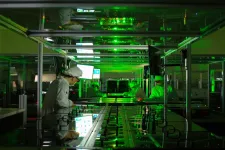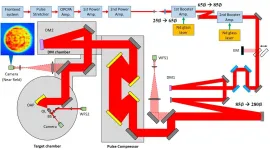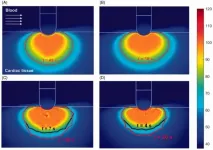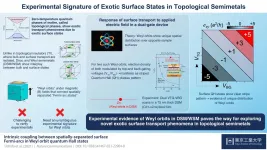(Press-News.org) WASHINGTON -- Researchers have demonstrated a record-high laser pulse intensity of over 1023 W/cm2 using the petawatt laser at the Center for Relativistic Laser Science (CoReLS), Institute for Basic Science in the Republic of Korea. It took more than a decade to reach this laser intensity, which is ten times that reported by a team at the University of Michigan in 2004. These ultrahigh intensity light pulses will enable exploration of complex interactions between light and matter in ways not possible before.
The powerful laser can be used to examine phenomena believed to be responsible for high-power cosmic rays, which have energies of more than a quadrillion (1015) electronvolts (eV). Although scientists know that these rays originate from somewhere outside our solar system, how they are made and what is forming them has been a longstanding mystery.
"This high intensity laser will allow us to examine astrophysical phenomena such as electron-photon and photon-photon scattering in the lab," said Chang Hee Nam, director of CoReLS and professor at Gwangju Institute of Science & Technology. "We can use it to experimentally test and access theoretical ideas, some of which were first proposed almost a century ago."
In Optica, The Optical Society's (OSA) journal for high impact research, the researchers report the results of years of work to increase the intensity of laser pulses from the CoReLS laser. Studying laser matter-interactions requires a tightly focused laser beam and the researchers were able to focus the laser pulses to a spot size of just over one micron, less than one fiftieth the diameter of a human hair. The new record-breaking laser intensity is comparable to focusing all the light reaching earth from the sun to a spot of 10 microns.
"This high intensity laser will let us tackle new and challenging science, especially strong field quantum electrodynamics, which has been mainly dealt with by theoreticians," said Nam. "In addition to helping us better understand astrophysical phenomena, it could also provide the information necessary to develop new sources for a type of radiation treatment that uses high-energy protons to treat cancer."
Making pulses more intense
The new accomplishment extends previous work in which the researchers demonstrated a femtosecond laser system, based on Ti:Sapphire, that produces 4 petawatt (PW) pulses with durations of less than 20 femtoseconds while focused to a 1 micrometer spot. This laser, which was reported in 2017, produced a power roughly 1,000 times larger than all the electrical power on Earth in a laser pulse that only lasts twenty quadrillionths of a second.
To produce high-intensity laser pulses on target, the generated optical pulses must be focused extremely tightly. In this new work, the researchers apply an adaptive optics system to precisely compensate optical distortions. This system involves deformable mirrors -- which have a controllable reflective surface shape -- to precisely correct distortions in the laser and generate a beam with a very well-controlled wavefront. They then used a large off-axis parabolic mirror to achieve an extremely tight focus. This process requires delicate handling of the focusing optical system.
"Our years of experience gained while developing ultrahigh power lasers allowed us to accomplish the formidable task of focusing the PW laser with the beam size of 28 cm to a micrometer spot to accomplish a laser intensity exceeding 1023 W/cm2," said Nam.
Studying high-energy processes
The researchers are using these high-intensity pulses to produce electrons with an energy over 1 GeV (109 eV) and to work in the nonlinear regime in which one electron collides with several hundred laser photons at once. This process is a type of strong field quantum electrodynamics called nonlinear Compton scattering, which is thought to contribute to the generation of extremely energetic cosmic rays.
They will also use the radiation pressure created by the ultrahigh intensity laser to accelerate protons. Understanding how this process occurs could help develop a new laser-based proton source for cancer treatments. Sources used in today's radiation treatments are generated using an accelerator that requires a huge radiation shield. A laser-driven proton source is expected to reduce the system cost, making the proton oncology machine less costly and thus more widely accessible to patients.
The researchers continue to develop new ideas for enhancing the laser intensity even more without significantly increasing the size of the laser system. One way to accomplish this would be to figure out a new way to reduce the laser pulse duration. As lasers with peaks power ranging from 1 to 10 PW are now in operation and several facilities reaching 100 PW are being planned, there is no doubt that high-intensity physics will progress tremendously in the near future.
INFORMATION:
Paper: J. W. Yoon, Y. G. Kim, I. W. Choi, J. H. Sung, H. W. Lee, S. K. Lee, C. H. Nam, "Realization of laser intensity over 1023 W/cm2," Optica, 8, 5, 630-635 (2021).
DOI: https://doi.org/10.1364/OPTICA.420520.
About Optica
Optica is an open-access, journal dedicated to the rapid dissemination of high-impact peer-reviewed research across the entire spectrum of optics and photonics. Published monthly by The Optical Society (OSA), Optica provides a forum for pioneering research to be swiftly accessed by the international community, whether that research is theoretical or experimental, fundamental or applied. Optica maintains a distinguished editorial board of more than 60 associate editors from around the world and is overseen by Editor-in-Chief Prem Kumar, Northwestern University, USA. For more information, visit Optica.
About The Optical Society
Founded in 1916, The Optical Society (OSA) is the leading professional organization for scientists, engineers, students and business leaders who fuel discoveries, shape real-life applications and accelerate achievements in the science of light. Through world-renowned publications, meetings and membership initiatives, OSA provides quality research, inspired interactions and dedicated resources for its extensive global network of optics and photonics experts. For more information, visit osa.org.
Media Contacts:
Aaron Cohen
(301) 633-6773
aaroncohenpr@gmail.com
mediarelations@osa.org
Recently, laser scientists at the Center for Relativistic Laser Science (CoReLS) within the Institute for Basic Science (IBS) in South Korea realized the unprecedented laser intensity of 1023 W/cm2. This has been a milestone that has been pursued for almost two decades by many laser institutes around the world.
An ultrahigh intensity laser is an important research tool in several fields of science, including those which explore novel physical phenomena occurring under extreme physical conditions. Since the demonstration of the 1022 W/cm2 intensity laser by a team at the ...
The health benefits of sardines and oily fish are widely known: their high levels of unsaturated fats help to regulate cholesterol levels and prevent the onset of cardiovascular diseases. However, the benefits don't end there. A study led by Diana Diaz Rizzolo, lecturer and researcher of the Universitat Oberta de Catalunya's (UOC) Faculty of Health Sciences and the August Pi i Sunyer Biomedical Research Institute (IDIBAPS), has discovered that the regular consumption of sardines helps to prevent the onset of type 2 diabetes. Nutrients found in high quantities in sardines - such as taurine, omega 3, calcium and vitamin D - help to protect against this disease which, according to CIBERDEM's Di@betes study, affects around 14% of the Spanish population over the ...
The published data provide additional detail of an initial analysis conducted in January, while more robust data from a complete analysis of the study was subsequently shared in March 2021.
Publication of initial primary analysis highlights cross-protection by the Novavax Covid-19 vaccine against the B.1.351 variant prevalent in South Africa during the study.
This is the first published study to show protection against mild Covid-19 caused by the B.1.351 variant circulating in South Africa.
An updated analysis of the study indicated 100% protection against severe Covid-19 due to the B.1.351 variant.
"An efficacy of 50% is sufficient to meet the World ...
UNIVERSITY PARK, Pa. -- Social media has become a platform for new mothers to openly share their experiences of the joys and challenges of parenthood. Researchers at Penn State and Dalhousie University have unraveled the sentiments in nursing mothers' tweets to better understand the factors influencing breastfeeding behaviors. They hope the findings can inform policies and interventions to support and improve resources for nursing mothers, such as breastfeeding support, workplace accommodations and technological aids such as apps.
"We are getting the raw sentiment of nursing mothers without putting them in a controlled experiment environment ...
The world's first-ever 'academic paper which is not a paper' is due to be presented by a Lancaster University research team at the premier international conference on human-computer interaction.
Dr Joseph Lindley, a researcher at Lancaster University's ImaginationLancaster design-led research laboratory, Dr Miriam Sturdee, from the University's School of Computing and Communications, Senior Research Associate Dr David Green and Research Associate Hayley Alter have been invited to take part in the 2021 ACM CHI Virtual Conference on Human Factors in Computing Systems in May.
Using the innovative 'Gather Town' online video-calling and conferencing platform, they have experimented in setting up a conference paper as an interactive but virtual ...
Clinical practice guidelines for dealing with the physical and mental health of transgender people highlight the current lack of a solid research base which must be improved, according to a new study published in the journal BMJ Open.
A team of researchers from Anglia Ruskin University (ARU) and King's College London searched world literature for all international clinical practice guidelines on the healthcare needs of gender minority and trans people.
Results showed that higher quality guidelines tended to focus mainly on HIV, and most others were on transition-related interventions. There were noticeable gaps in the topics of guidelines, with none addressing ...
An article published in International Journal of Hyperthermia proposes a more effective protocol for the treatment of cardiac arrhythmias when applying radiofrequency energy at the site of the arrhythmia by catheterization. The research results from the final year project (TFG) on the bachelor's degree in Biomedical Engineering by Sergi Coderch Navarro, supervised by Ana González Suárez and Oscar Camara, researchers with the PhySense group of the BCN MedTech Research Unit at the UPF Department of Information and Communication Technologies (DTIC). Sergi Coderch Navarro defended his TFG in July 2019 and was a runner-up in the 2019 Gemma Rossell i Romero Awards. Currently, Ana González Suárez is a postdoctoral ...
Scientists at Tokyo Institute of Technology experimentally verify the existence of exotic surface conduction states in topological semimetals (TSMs), materials that lie at the boundary between conductors and insulators, by performing voltage scans of these surface states on a thin film sample of a TSM. The findings can pave the way for future study and exploitation of such conduction states in realizing novel, quantum transport phenomena.
All of us are probably familiar with the idea of conductors and insulators. But what would you call a material that can conduct on the surface but insulate on the inside? Physicists call it a "topological insulator" (TI), a term that highlights the geometric aspect of its strange conduction behavior. Even stranger ...
ITHACA, N.Y. - Solar-power developers need to explore using lower-quality agricultural land for solar energy, incentivize dual-use (combined agriculture and solar) options, avoid concentrated solar development and engage communities early to achieve New York's green energy goals, according to forthcoming Cornell University research.
"As farmland is generally flat and cleared, agricultural land will be the prime target for future solar energy development," said Max Zhang, professor in the Sibley School of Mechanical and Aerospace Engineering. "Good farmland, however, is not ideal."
Zhang is senior author of "Strategic Land Use Analysis for Solar Energy Development in New York State," which will publish in August 2021 in Renewable Energy.
Under New York state's 2019 Climate ...
A recent study analyses data collect4d at 44 of the darkest places in the world, including the Canary Island Observatories, to develop the first complete reference method to measure the natural brightness of the night sky using low-cost photometers.
Of the 44 photometers in the survey, the Roque de los Muchachos Observatory (Garafía, La Palma, Canary Islands) stands out at the darkest of all the skies analysed.
The night sky is not completely dark; even in the remotest places there is a glow in the sky produced by natural components, both terrestrial and extraterrestrial, ...






